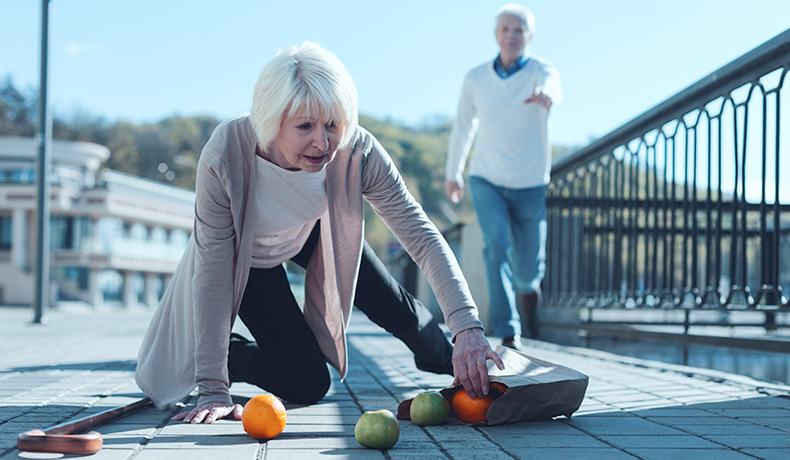
Handling Fall Prevention, Like a Boss
We’ve all taken a tumble at some point in life. Of course, in those first few years when learning to make our first steps, but also on random occasions throughout life too. A misjudged step, some black ice, or after one-too-many ‘club sodas’; a fall is something we’ve all come to accept as a common shortcoming that simply makes us human.
As a toddler, you’d pick yourself up, dust yourself off and think nothing of it. On those random occasions, a fall would tend to lead to nothing more than a light bruise and a temporarily damaged ego.
However, for those over the age of 65, one out of five falls is responsible for serious injury, such as broken bones or head trauma. Over 800,000 older patients are hospitalized each year because of a fall injury, and over 95% of hip fractures are caused by falling according to the CDC.
Physically, these numbers are terrifying, but it doesn’t stop there. Financially, the medical cost of falls tends to average at around $50 billion per year.
As we approach the U.S. Falls Prevention Awareness Day on September 22nd, we felt it absolutely necessary to construct our top 5 ways of handling fall prevention, like a boss. Helping you to ensure that your only fall this year is filled with pumpkin-spiced lattes, farmer’s markets, scented candles, and homemade pies.
Clear Out the Clutter
Your home should be your safe place, but how safe can it truly be with electrical cords, stray shoes, and loose rugs lurking around every corner? Take a moment to look around your home for potential hazards, you’ll be surprised at how many you find.
Focus primarily on ‘high-traffic areas’ and aim to keep those clear at all times. Secure any loose rugs and carpets with slip-resistant backing, tacks, or double-sided tape; and have any loose floorboards replaced immediately. Move low coffee tables and plant pots or stands to the edges of each room, and find alternative routes for those protruding wires begging for an ankle snag.
Use non-slip mats in your bathroom, both inside and outside of the shower or bathtub, and always remain alert of spilled liquids or dropped greasy foods – get those cleaned up as quickly as possible!
Ask yourself the question, ‘would I feel confident walking around my home in the dark?’. Keep your home in a constant state of ‘yes’ to that question.
Focus on Footwear
High heels, slick-soled shoes, and loose-fitting flip flops are regular transporters of a trip down Fall Avenue. They may be comfortable, convenient, or aesthetically pleasing, but a fractured hip can quickly change your opinion on those bargain slippers found in a beach-side stall in Acapulco.
Proper fitting, sturdy, flat shoes with a non-slip sole are the way forward. They’ll reduce those fall chances massively, and may even reduce muscle and joint pain too.
Steady Your Walk
Assisted devices such as a cane or a walker can be a game changer in the realm of fall prevention. As long as it’s the right size and fit for your body, an assisted device can provide incredible amounts of additional support when enjoying a leisurely stroll, especially on uneven walkways or at newly discovered, unfamiliar locations.
Your physical therapist or GP can help you decide which devices may be the best for you, as well as teach you how to use them safely.
Keep Moving
As long as you’ve been given the ‘go ahead’ from your healthcare provider, consider some activities that will help improve your balance, coordination, strength, agility, and flexibility!
Some activities can include walking, yoga, aquarobics, Tai chi, or even a graceful dance class (you know you’ve always wanted to Waltz the night away, now’s your chance!).
If apprehensive about trying a new activity, speak with your physical therapist, they may be able to provide a customized routine to help build the strength and balance needed for your new desired activity.
Have a Great Sense of your Senses
Specifically sight and sound. These two senses are paramount when it comes to fall prevention. Obviously, sight is hugely important to maintaining balance, but many people are surprised to know that hearing problems can cause major balance disorders too.
Be sure to get your eyes and ears tested every year; and if required, update your glasses, contact lenses, or hearing aides.
If accustomed to bifocal or progressive lenses, it may be wise to consider getting a pair of prescription glasses specifically for outdoor activities. This reduces the possibility of your lenses distorting objects that could appear closer or farther away than they really are.
Here’s an additional tip that isn’t specifically related to fall prevention, but instead more related to the impact a fall could have:
Keep your bones healthy and strong.
Simply, by getting both enough calcium and vitamin D in your diet while quitting smoking and limiting your alcohol use can make all the difference between a light bruise and broken bone.
Of course, falls are inevitable. They’re often out of our power, happen before we know it, and can have long-lasting effects. But fall prevention is fully within our power, with some small changes like those mentioned above, we can manage the risk, and reduce it to a level almost not worth worrying about.
